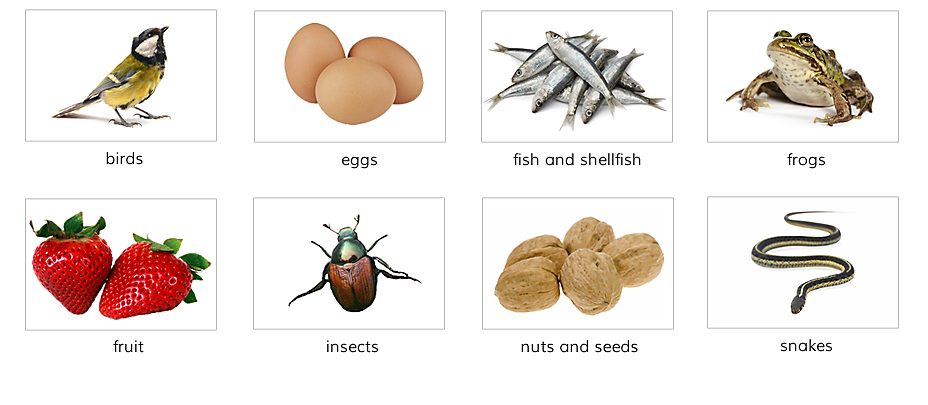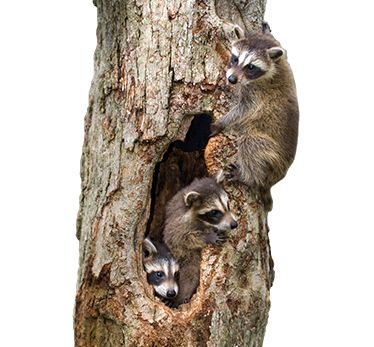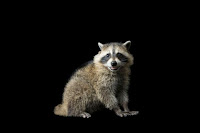WHAT IS RACCOON?
RACCOON
![Picture of a raccoon]()
![Picture of a raccoon]()
![Picture of a raccoon]() Scientific Classification
Scientific Classification
Geography

Raccoon Habitat
11 Fun Raccoon Facts
Raccoon, (genus Procyon), also called ringtail, any of seven species of nocturnal mammals characterized by bushy ringed tails. The most common and well-known is the North American Racoon (Procyon lotor), which ranges from northern Canada and most of the United States southward into South American.
| Kingdom: | Animalia |
| Phylum: | Chordata |
| Class: | Mamallia |
| Order: | Carnivora |
| Suborder: | Caniformia |
| Family: | Procyonidae |
| Genus: | Procyon |
| Species: | P. lotor |
Common Name: Raccoon
Scientific Name: Procyon lotor
Type: Mammals
Diet: Omnivores
Group Name: Nursery
Geography

The raccoon is native to North America and
can be found throughout the United States, except for parts of the Rocky
Mountains, and southwestern states like Nevada, Utah, and Arizona. It
can also be found in parts of Canada, Mexico and the northern-most
regions of South America. During the 20th century, the
species was introduced to other parts of the globe, and now has an
extensive presence in countries like Germany, Russia, and Japan.
Size and Weight
The adult raccoon is a medium-sized
mammal and the largest of the Procyonidae family. It averages 24 to 38
inches in length and can weigh between 14 to 23 lbs., or more, depending
upon habitat and available food. The male raccoon, or boar, is slightly
larger than the female, also referred to as sow. The young are called
kits.
Physical Features
The mask of black fur that covers
its eyes is its most characteristic and familiar feature. One hypothesis
for the dark fur is that it may help reduce glare and enhance the
nocturnal animal’s night vision. The species has grayish brown fur,
almost 90% of which is dense underfur to insulate the animal against the
cold. Five to eight light and dark rings alternate on its tail. Because
its hind legs are longer than the front legs, a raccoon often appears
hunched when they walk or run. The five toes on a raccoon’s front paws
are extremely dexterous, functioning essentially as five little fingers
which allow it to grasp and manipulate food it finds in the wild as well
as a variety of other objects, including doorknobs, jars, and latches. A
raccoon’s most heightened sense is its sense of touch. It has very
sensitive front paws and this sensitivity increases underwater. When
able, a raccoon will examine objects in water.
Diet


Raccoons are omnivores with an opportunistic diet; eating almost
anything they can get their paws on. In urban areas, where wildlife and
fresh vegetation are limited, raccoons will be more likely to eat human
food and invade trashcans. The majority of their diet consists of sweet
foods like fruits and invertebrates.
Raccoon Habitat 
Traditionally, raccoons prefer heavily wooded areas with access to trees, water and abundant vegetation. There, they make their dens in the hollow parts of trees as well as abandoned burrows, traveling up to 18 miles to forage for food. Raccoons are extremely adaptable. They are often found in suburban and urban areas, making their homes in man-made structures like attics, sewers, barns and sheds. In urban areas, raccoons tend to stay closer to their dens with a range of only about 1 mile, depending on their age and sex
Breeding and Social Structure
The animal is nocturnal,
mostly foraging and feeding at night. Though previously thought to be
quite solitary, there is now evidence that the species congregates in
gender-specific groups. Mating season for raccoons falls generally
anytime between January and June. Most females begin reproducing around
the age of one. The female has a 65-day gestation period and gives
birth to two to five kits, usually in the spring. A mother usually
separates from other raccoons to raise her young alone. The male does
not participate in the raising of the kits. The black mask is already
visible on newly-born kits. The kits stay in the den with their mother
until they are between 8-10 weeks old, and will stay with their mother
until they reach 13-14 months of age.
Raccoon Behavior
Activity:
Nocturnal in nature, raccoons are mostly active at nighttime. They are
most active in spring, summer and fall, and will sleep in their dens for
most of the winter.
Reproduction:
Reproduction begins in late winter. Females, or sows, usually give
birth to 1-6 baby kits in April or May. Mothers are very protective of
their young until they separate after about a year.
Social Interaction:
Raccoons are independent after 12-14 months of age. Adults live in
loose knit communities of 4 - 5 raccoons for better protection against
predators.
Communication: Raccoons communicate with each other using over 200 different sounds and 12-15 different calls.
Skills:
Raccoons possess amazing dexterity that gives them the ability to open
doors, jars, bottles and latches. They are also great climbers, which
allows them to better access food and shelter.
- The raccoon’s scientific name, Procyon lotor, means “washer dog” although it is a closer relative to the bear family.
- Raccoons have a large array of vocalizations. Scientists have determined that they can make over 51 different sounds! They purr, whistle, growl, hiss, scream and even whinny.
- Raccoons have been kept as pets (President Coolidge and his wife had one named Rebecca), and while young, seem happy to be in human company. As they mature, especially during mating season, they can become increasingly destructive and aggressive.
- A raccoon’s hands are so nimble they can unlace a shoe, unlatch a cage and deftly retrieve coins as thin as dimes from your shirt pocket.
- In spring, female raccoons give birth to three or four young. The baby raccoon’s eyes do not open until 20 days or so after birth. It won’t have rings on its tail, or a mask around its eyes, until it’s older. Baby raccoons stay in the den for eight to ten weeks. The mother raccoon is very protective of her babies—she won’t even let the father near them.
- On the mammal IQ scale raccoons rank higher than cats and just below monkeys.
- Christopher Columbus is the first individual we know of to have written about the species.
- The raccoon has the ability to rotate their hind feet a full 180 degrees to allow for their ability to climb down from trees head first.
- The word raccoon, derived from the Algonquin Indian word “arakun” means “he scratches with hands”.
- Raccoons are more likely to be killed by an automobile than by another predator.
- A raccoon can run at speeds of up to 15 miles per hour.
https://joshmosey.wordpress.com/2013/06/04/11-fun-raccoon-facts/
QUESTION
1. What is Raccoons?
a. Raccoons ia a medium-sized mammal that native to north america characterized with bushy-ringed tail
b. Raccoons is a mammal that comes from cat family
c. Raccoons is an animal similiar with kangoroo
d. Raccoons is a medium-size reptile that native to north america
e. All of the choices are wrong
2. Based on the text, how much raccoons can make different sounds?
a. 50
b. 201
c. 51
d. 49
e. 212
3. Raccoons almost can eat anything but in urbans life, Raccoons will be more likely to eat...
a. invertebrates
b. fruit & vegetables
c. raw meat
d. fish
e. human food and invade trashcans
4. According to the text, these are physical features of Raccoons, except...
a. It has bushy ringed tail
b. It has long ears, silky fur, white mask around it faces, and short tail
c. The species has grayish fur
d. Its hinds legs are longer than front legs
e. It has very sensitive front paws
5. When is mating season for raccoons...
a. august-oktober
b. January-June
c. September-January
d. january
e. june
QUESTION
1. What is Raccoons?
a. Raccoons ia a medium-sized mammal that native to north america characterized with bushy-ringed tail
b. Raccoons is a mammal that comes from cat family
c. Raccoons is an animal similiar with kangoroo
d. Raccoons is a medium-size reptile that native to north america
e. All of the choices are wrong
2. Based on the text, how much raccoons can make different sounds?
a. 50
b. 201
c. 51
d. 49
e. 212
3. Raccoons almost can eat anything but in urbans life, Raccoons will be more likely to eat...
a. invertebrates
b. fruit & vegetables
c. raw meat
d. fish
e. human food and invade trashcans
4. According to the text, these are physical features of Raccoons, except...
a. It has bushy ringed tail
b. It has long ears, silky fur, white mask around it faces, and short tail
c. The species has grayish fur
d. Its hinds legs are longer than front legs
e. It has very sensitive front paws
5. When is mating season for raccoons...
a. august-oktober
b. January-June
c. September-January
d. january
e. june



Komentar
Posting Komentar